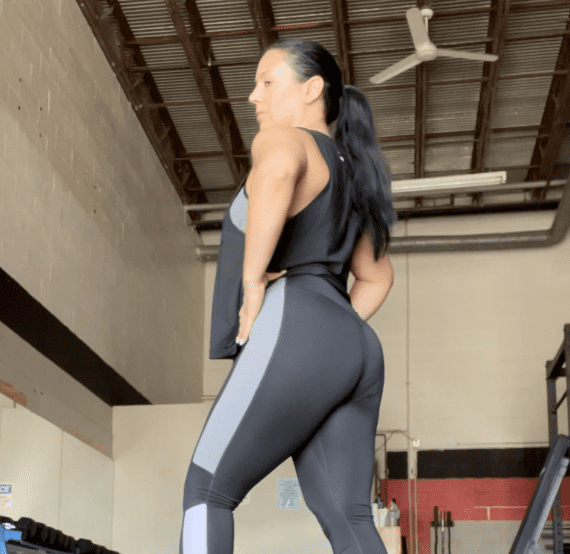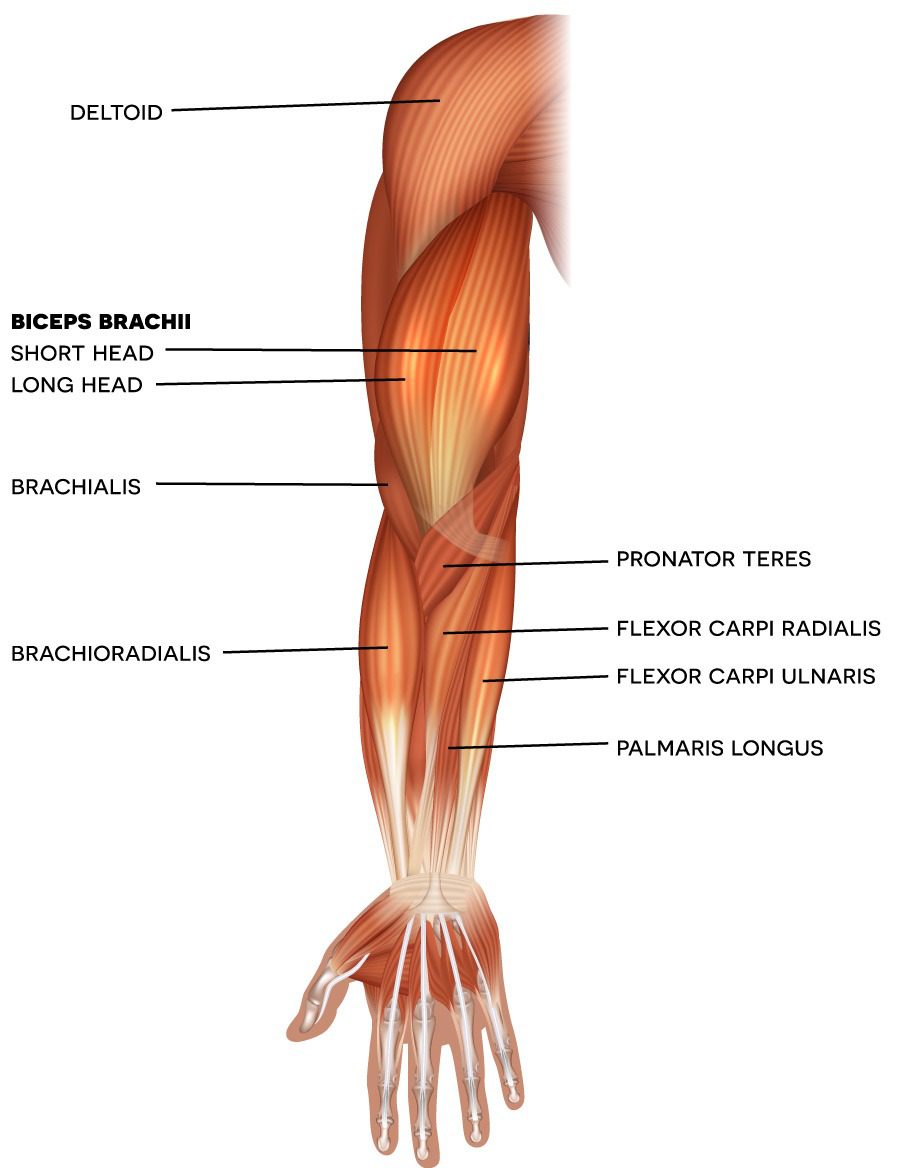Hammer Curls: Form & Variations for Bigger Biceps
TOPIC: Strength & Conditioning
Want thick, juicy biceps that pop out of your T-shirt? Then you should probably be doing more hammer curls. This curl variation shoots a powerful pump through your biceps and forearms that lead to big gains in a different way than traditional bicep curls.

Written By
sari terranova
Sari Terranova is a total supermom, CPT, and nutrition coach who introduces women and youth athletes to the power of weightlifting, bodybuilding, powerlifting, and functional strength training.
Insta
Programs
Website
Strong Arms Are Sexy 🙂
Some will call it a “vanity” exercise, but the bicep curl is an undeniable workout staple for physique competitors and strongmen and women alike.
Strong arms not only look good, but they’re also necessary for functional everyday movements. We all need to be able to lift, carry, push, and pull – just ask any parent who lugs around an infant car seat.
There are dozens of bicep curl variations, from Zottmans to spider curls, but one of the most popular deviations from the standard is the hammer curl.
What makes the hammer curl different? Grip. The hammer curl requires a neutral grip rather than a supinated (palms-up) grip. This activates the forearm as well as the upper and outer bicep, giving you balanced size and strength gains. No Popeye arms here!
Hammer Curls vs. Traditional Bicep Curls
The arms are comprised of over twenty muscles, but the biceps get the most glory as they are superficially located and tend to be the most visible.
Traditional bicep curls primarily work the biceps brachii, which is partially responsible for elbow flexion and rotation of the forearm.
Hammer curls are unique as they isolate the brachioradialis (forearm) and the brachialis, the long deep muscle hidden beneath the bicep, which is actually a much stronger driver of flexion than the biceps brachii.
Targeting the brachialis not only increases overall arm strength, but also increases upper arm thickness and props up the superficial bicep muscle. Because of this, hammer curls are your best bet to get that sought-after bulge and chiseled look.

How to Do Hammer Curls
You can perform the hammer curl from either a seated or standing position, and as a unilateral or bilateral movement.
Performing the curl from a seated position further isolates the targeted muscles and limits momentum cheat. Another alternative is to set the bench at an incline to increase the range of motion and target the upper bicep.
Performing from a standing position engages the core and may allow for heavier weight as more muscles are recruited to assist.
Start with the dumbbells at your sides, palms facing each other. Keep your shoulders erect and your arms close to your body. Then bend your arms at the elbow and pull the weights up until your thumbs are close to your shoulders.
Pause at the top and then slowly lower the weights to starting position.
If performing as a single-armed movement, alternate sides or complete all reps per side (a good choice for correcting imbalances) before switching to the other side.
Points of Performance
While curls are simple, they are often performed incorrectly. The easiest way to cheat yourself of the benefits of any type of curl is to execute them with poor form or inappropriate weight.
Follow these cues to squeeze the most gains out of your hammer curls.
Set Your Grip
The hammer curl is defined by the neutral grip, but that doesn’t mean there’s only one way to grasp a dumbbell.
I find that using a thumbless grip for curls grants a stronger mind-muscle connection and greater muscle activation.
Gripping the dumbbell in the middle or closer to the front of the weight can also make an impact. You may find that if your grip strength weakens, you can bang out a few more reps on your last sets by shifting your hands forward so the front end of the weight rests on your index finger and thumb.
Think “T-Rex Arms”
Keep your upper arms and elbows pinned to your sides throughout the movement.
If your elbows are moving away from or in front of your body, this is a sign that the weight is too heavy. The only part of your body that should be moving is from your elbow to your fingertips.
Use Tempo
“Slow is smooth, smooth is fast.” In other words, slowing your tempo yields faster results.
If you are simply chasing a pump, by all means bang out your reps and go, but playing with tempo on the concentric (lifting the weight to your shoulder), eccentric (lowering the weight to starting position), and mindfully pausing at the top and bottom of the movement can all impact your gains and ability to break through plateaus.
Coach’s Tip: To better understand tempo training and get the most out of your hammer curls, check out my other blog: Understanding Tempo Training For Maximum Strength Gains
Don’t Cheat by Swinging
There’s always that one dude in the gym trying to curl dumbbells that are way too heavy and using his entire body to heave the weight up.
This is ineffective at best and can result in injury at worst. Don’t be that dude.
Choose a weight that’s challenging on the last reps, but that you can still lift with integrity – elbows at your sides, shoulders back, no rocking.
Hammer Curl Variations
The hammer curl is as versatile as the traditional bicep curl and can be performed with many different pieces of equipment: dumbbells, kettlebells, hammer grip barbells, resistance bands, cables, benches, you name it.
This makes hammer curls a convenient exercise you can perform at home, in the gym, or on the go.
Cross-Body Hammer Curl
The cross-body hammer curl is very similar to the standard hammer curl, but in this variation, you lift the weight across your chest to the opposite shoulder instead of straight up and down.
There is not any definitive evidence that would indicate a clear advantage of one variation over another, although some suggest the cross-body curl may have a slight edge in targeting the long head of the bicep. It really comes down to personal preference and the muscle activation you feel.
Chest-Supported Hammer Curl
The chest-supported hammer curl employs an incline bench to eliminate momentum cheat and deltoid activation, helping you zero in on the forearm and brachialis.
With a dumbbell in each hand, straddle the incline bench and rest your chest on the upper portion of the bench. Your arms should be hanging perpendicular to the floor, palms facing one another.
Keep your upper arms and elbows close to your body and raise the dumbbells to your shoulders, pausing at the top, and then lower them slowly. Extend your arms fully at the bottom of the movement but do not lock out your elbows or let go of the tension (no dead arm float!) before you flex the weight back up.
Banded Hammer Curl
Resistance bands are great tools for hammer curls and make it easy to do them anywhere – throw them in your luggage, stow a couple in an office drawer, bring one to the park when you take a walk – get that pump on the go! They also make a great warm-up for pull days.
Stand on one end of a long loop resistance band with the band bisecting the bottom of your feet. Gripp the upper portion of the band with a neutral grip and bend your elbows at a 90-degree angle, hands in front of your body.
There should be a semicircle of the band hanging between your hands (the lower you grip the band, the higher resistance you will have, and the longer this semicircle will be). Adjust your grip to the desired resistance and complete the movement as you would if you were holding dumbbells: shoulders back, elbows pinned, pause at the top, controlled tension at the bottom.
Preacher Hammer Curl
The preacher hammer curl set-up is unique. Although fixed in place, your elbows are placed in front of your body, allowing for maximum isolation of the brachioradialis and brachialis.
Adjust the seat to the preacher curl bench so that the backs of your upper arms lie flat on the bench from your armpits to your elbows.
Start with your elbows flexed, palms facing one another, and dumbbells up near your shoulders. Slowly lower the weights, keeping the backs of your arms pressed against the bench. Fully extend your arms, but keep a slight bend in the elbow (don’t lock out) and maintain tension throughout the movement, curling the weight back up to starting position.
This movement can also be performed unilaterally.
Cable Hammer Curl
The cable machine offers a variety of setups for the hammer curl, from forward to away facing, bilateral or unilateral, various grip attachments, and even preacher curls.
Cables provide constant time under tension, are easy on joints, and allow you to use fractional weights so you can consistently and safely employ progressive overload.
I prefer to use the rope attachment for bilateral forward-facing curls and single-arm away-facing curls, but it’s fun to experiment with different setups to shake up your arm day routine once in a while.
They say that in life, sometimes you’re the hammer, and sometimes you’re the nail. I’m going to recommend that you incorporate one of the above variations into every arm day workout, and BE THE HAMMER!
Happy Hammering Heroes!
Find Your Perfect Training Plan
Sometimes all you need to reach your destination on your fitness journey is an expert guide. Look no further, we've got you covered. Browse from thousands of programs for any goal and every type of athlete.
Try any programming subscription FREE for 7 days!
Related Articles
You May Also Like...
The Ultimate Guide to Lunges: Queen of all Glute Exercises
Your glutes are the largest muscle group in your body. They’re responsible for almost everything your legs do—walking, running, jumping, squatting, lunging, and just standing upright. As far as moving through space goes, strong glutes are the bedrock of overall...
A Beginner’s Guide to Steel Mace Training
Think you’ve mastered kettlebells? Meet the steel mace — the brutal, offset weapon that forces your body into three-dimensional stability, grip work, and rotational strength. Ancient tool. Modern performance.Written Byjesse grund Jesse Grund’s passion is simple: coach...
The Best Bench Press Warm Up Strategy
We get it. You’re pressed for time in the gym. But skipping the warm up is the surest way to underperform and risk injury. This 3D approach to your bench press warm up not only allows you to lift more weight, but also ensures the long-term health of your shoulder...
The Ultimate Guide to Lunges: Queen of all Glute Exercises
Your glutes are the largest muscle group in your body. They’re responsible for almost everything your legs do—walking, running, jumping, squatting, lunging, and just standing upright. As far as moving through space goes, strong glutes are the bedrock of overall...
A Beginner’s Guide to Steel Mace Training
Author: Jesse Grund
Mace training will make you a better mover without it’s not confining you to a fixed space or predetermined range of motion. Second, it’s an offset load with 80 to 90 percent of the weight in the head. You’re also constantly having to resist rotation, which creates greater core engagement.

Want more training content?
Subscribe
For Coaches
For Athletes
About
Support
Training Lab
Access the latest articles, reviews, and case studies from the top strength and conditioning minds in the TH Training Lab!
Made with love, sweat, protein isolate and hard work in Denver, CO
© 2024 TrainHeroic, Inc. All rights reserved.





